 Logo handmade by Bannister
Column by Scott Green
Logo handmade by Bannister
Column by Scott Green
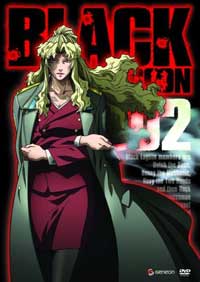
Anime Preview Black Lagoon Volume 2 To be released by Geneon July 24, 2007
Madhouse, the studio that left a blood stain on the North American anime consciousness with Ninja Scroll, but which also produced a host of artier fare, such as Paprika, packs a volatile rogues' gallery into an exotic locale and then settles back to enjoy the ricocheting bullets and detonating explosions. Glowing in the reflection of the tropical sun or the neon lights, the sigh as impressively hard people athletically engaging in gunplay is as attractive and as adrenaline soaked as any live action film. The second volume of Black Lagoon locks in the factors that establish Black Lagoon as the preeminent gunslinger anime. Chiefly, the anime’s particular verve is due to the sense that despite the huge body count, there is some significance to what the characters are doing. They are so occupied by the rush into violence that their committal blurs the line been escapism and substance. That animalistic urge becomes a provocative point addressed through the people on screen. What goes wrong to foster such a passion for violence? Along with nods to other live action traditions, Hong Kong's heroic bloodshed pistol operas are a key thread in the composition of Black Lagoon. The king of that brand of movie, Hard Boiled opens with the super cop played by Chow Yun Fat in a bust gone wrong. After navigating through a hail of bullets, taking out some adversaries, losing some compatriots, and surviving the spectacularly deadly scene, his commanding officer admonishes Chow Yun Fat's character for playing god. In the case of Black Lagoon, that sort of step-back introspection is concurrent with the violence. It's not exactly a come-down and not exactly a reprimand. Instead, it bathes in blood and at the same time indicts the enterprise as pathological. The anime does not deny that the viewer is going to this series for an exhibition of people hurting and getting hurt or that the protagonists' clearly unrestricted use of deadly force is part of what makes them "villains" on the greater moral balance sheet. Instead, an extra tension is built from the characters and the anime itself acknowledging the implications and proceeding to blast away regardless. While this is the chief thrill of the anime, witnessing the characters' need and willingness to kill is a barbed experience.

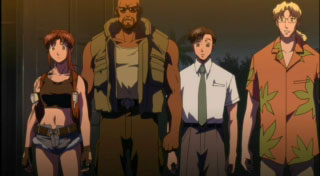

The climax of Black Lagoon's first real status quo story arc features the anime's bad-ass, hot body Revy in her trademark cut-off daisy dukes and sleeveless top, strolling the deck of a ship, a gun in each hand and a predatory sneer on her face. Almost in the manner of a video game, she's simply moving through a space, plugging anyone who she encounters. In this case, the action is prosecuted with few dashes or quick motions and highlighted by few explosions. The engagement is not the flashiest action, but the "Charles Whitman" approach to the mission is disconcerting, even to her companions. Without showcasing the best animation Madhouse has to offer, the gritted teeth counts for a lot. Seeing the wholesale execution of a force whose interest conflicts with those of the protagonists sells the notion that Black Lagoon is intent on capturing dangerous people in dangerous situations. By hooking up with the American ex-patriot pirates of Lagoon Company, the point of view character Rokuro Okajima, a former white collar worker rechristened "Rock", certainly seems to have fall in with the wolves. In the lawless community of the outlaw port of Roanapur, Thailand, Revy is in her natural element. The squad of neo-Nazis that Lagoon Company must content with on a retrieval mission are as much outsiders as Rock in this scrappy wild-east. In keeping with Revy's approach to dispatching them, these are almost video game foes. These aren't strictly comedy Nazis, but they are ill prepared intruders. Not only are they green to combat, the political idealism inherent in being a neo-Nazi is entirely foreign to the situational allegiances of Roanapur. What they provide the anime is that they are suckers in this situation, but they are suckers with live rounds. In this case, the uninspiring adversary and straight forward scenario allows the anime to focus on how its protagonists handle danger without much distraction from its cause. Mid-scenario, the story creates a tense dead-space, and then uses that to lay a solid character foundation. As obvious and potentially forgettable as sunken treasure and Nazi brown shirts might be, the character performances and what those performances establish make the episodes unforgettable. With Revy and Rock trapped in a sunken World War II submarine, surrounded by the skeletons of the sub's crew, with neo-Nazi's travelling down to kill them, the anime reveals the secret origin of its sociopath killer. The revelation is provoked by a demonstration of the divide between Revy's world and the ideal notions of what Rock left in abandoning Japanese corporate culture in favor of joining Lagoon Company. Presented with evidence of a gunfight between an SS officer and the crew of the sub as well as objects that the crew had a stake in, either family pictures or symbols of pride such as metals and insignia, Revy commences grave robbing. Rock expresses his unease at what Revy's actions represent. These characters are foils, and in all likelihood, while their respective will ultimately be bridged, that they will never entirely see eye to eye. Locked together in the submarine, when Revy turns on Rock and confronts him about walking into her world without committing to its tenets, her feral menace is palpable. She drops her back-story on Rock. True to the character and true to the anime, it's a no BS story. While it suggests the anime/manga standard of a single event that changes or solidifies everything, it's no hoary tear jerker. Her delivery is as anti-sentimental as her stepping over corpses. A lazier production would rest on instantly noticeable traits of this young woman, namely the obvious physical ones: chest, tribal tattoos and short shorts. With her grave scowl and ingrained anger, as earnestly threatening her companion, she’s far more fascinating than her Laura Croft appearence would suggest. With Sunao Katabuchi's direction, working off Masanori Shino's character designs, there is a formidable ferociousness to this personality that makes Black Lagoon arresting.
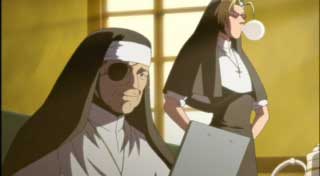
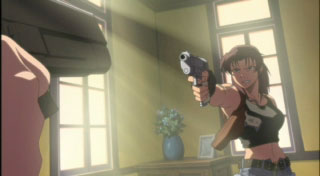
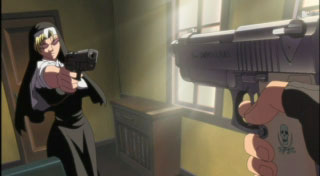
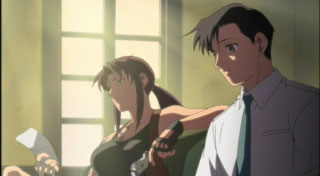
With the Nazis and the character roadmap out of the way, the second half of the volume has a more open field to play around with the exotic nature of Roanapur. The next stand alone episode is still mining the character drama of whether Revy can accept Rock as part of her team, rather than just an outsider hanging on. Sent into the thick of the city’s human wildlife, Rock emerges as something other than a narrative device. He establishes himself as a person with more depth than the typical pushed around POV cipher, both demonstrating solid boundaries past which he will not be pushed, and demonstrating that the skills he learned in the cut throat, manipulative business world are not entirely useless in Roanapur’s double dealing web of factions. The episode’s mini-tour of the expanded Roanapur feeds Lagoon's approach of packing the locale with various standards from crime fiction, and through their unrestrained interaction, making them a bit stranger and a bit more dangerous. There's an overview of its particularly pornography trade, ending with the harried captain of the Russian mafia (the scarred woman of the cover art) editing features herself. Then, there's a stop off at the Church of Violence. Nuns-with-guns have been done before. Chrono Crusade certainly helped to cement the presence of the idea in anime/manga. Black Lagoon isn't here to revolutionize the pulp conceit, but it does revitalize it. With Revy's lethal potential established, characters who can convincingly meet her stare become that much more impressive. A hardened looking, one eyed Mother Superior paired with an opposite number to Revy (short fuse and quick trigger, rather good looking) along with an impression of a functioning criminal enterprise whose logistics half work, the Church of Violence represents a very intriguing gateway to the competition offered by Roanapur. The volume's final episode tosses a match into this combustible situation. Lagoon Company starts this new story with a bit of human trafficking. Blow back comes quickly in the form of the sole muscle for a struggling South American cartel. A quiet, mousy woman in the prototypical French maid outfit shows up at Lagoon Company's home Yellow Flag bar. Yes, this is a played out anime fetish being re-used. If there's a twist on this character, it is that the demure personality that is supposed to accompany her type is exaggerated into dispassionate coldness. In the vein of the Church of Violence, when she demonstrates that she can send packing a seedy bar full of men playing cards with their pistols sitting on the table, her credentials have been established. There is only a flashing tease for this character in action, but when turns Terminator on the place and lights it up Desperado style, it's a great argument for the exciting potential of excessively violent anime and why we're so addicted to consuming it.

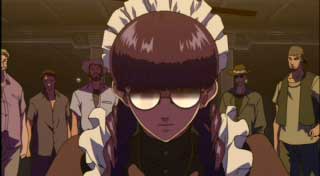
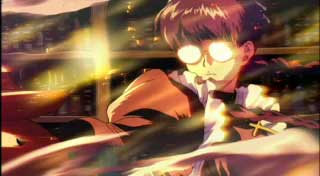
For more commentary see the AICN Anime MySpace.
